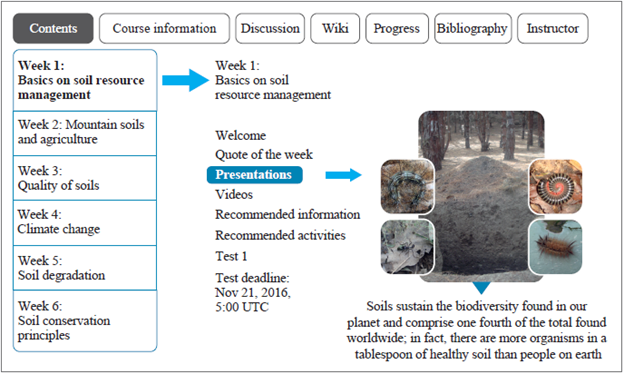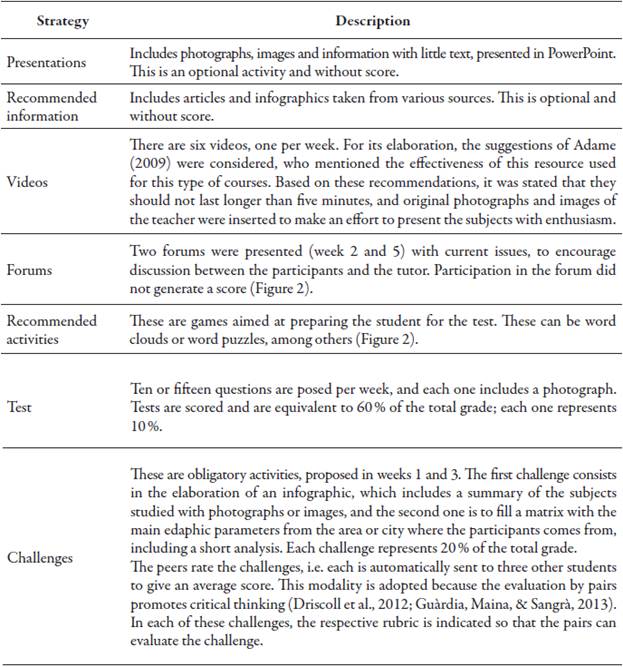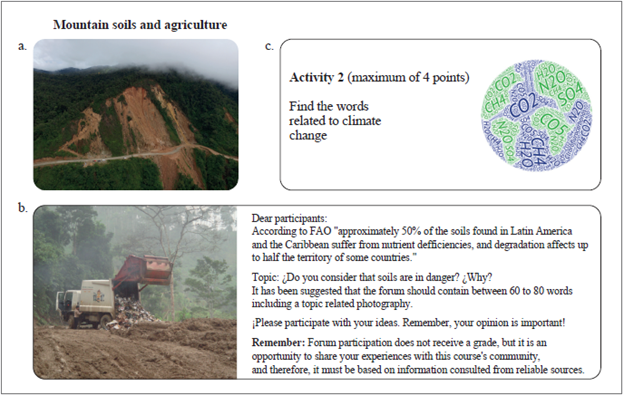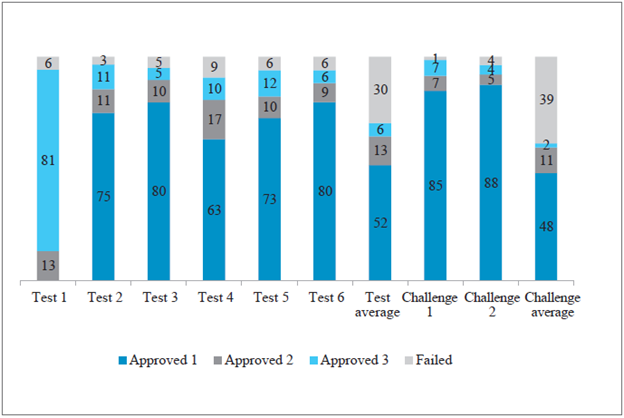Introduction
It is assumed that soil science is above all related to agriculture (Baveye, 2007). However, it goes much further, since it is linked to ecology, biology, hydrology, economy and many other sciences, because it is the basis for the production of food and many pharmaceutical and genetic inputs. Moreover, it also intervenes in climate regulation, hosts a quarter of the biodiversity of our planet, and constitutes a supply of fuels, infrastructure and ecosystem services, among others (Arnalds, 2007; Arnold, 2007).
For the diverse functions that this resource fulfills, it is important that both teaching and learning about this science reach a wide group of people, who could interact and contribute to soil conservation and its rational management. Technology and the Internet can be ways of spreading the message, since these resources are being used successfully in teaching, thanks to the easiness and progressive interest that their application in education has awakened (Anderson, Huttenlocher, Kleinberg, & Leskovec, 2014; Wade, Rasmussen, & Fox-Turnbull, 2013).
The information reported on the use of information and communication technologies (ICT) linked to the teaching of soil science at the university level is very scarce, only the works of Mamo et al. (2011), Reuter (2007) and Lozano, Ruiz and Lozano (2015) stand out the use of ICT in the education of this science.
The use and advantages of ICT have been widely recognized in higher education systems (Dumpit & Fernández, 2017; Edel-Navarro, 2014), particularly massive open access online courses (MOOC), which have caused great enthusiasm in the academy.
However, they also generate controversy, as there are still no answers to various questions related to pedagogical principles, effective designs, copyright and quality assurance (Gašević, Kovanović, Joksimović, & Siemens, 2014; Shapiro et al., 2017). But still, the use of MOOCs has increased in recent years (Conole, 2013, Driscoll, Jicha, Hunt, Tichavsky, &Thompson, 2012, Song, Singleton, Hill, & Koh, 2004).
In general, this type of courses does not include the payment of fees or prerequisites other than Internet access and language management (McAuley, Stewart, Siemens, & Cormier, 2010). Further, these arise from a social philosophy of open learning, and connect with a trend that has received different names, under the concepts of open information, open source, open standards and open access, among others. The “open” trend is based on two processes: a technological one, which allows content to be open and accessible, and a legal one, that provides free access.
These efforts are carried out with the intention that there is a democratic distribution of knowledge, which represents a great opportunity for countries (Ramírez, 2013), and is considered a right that must reach all citizens (United Nations Educational, Scientific and Cultural Organization [Unesco], 2002). Their purpose is to create communities of professionals who can use these open training strategies for their professional development, becoming the main source of feedback, fostering learning possibilities and becoming agents of innovation and change in higher education (Calvo, Rodríguez, & Fernández, 2016; Ossiannilsson, Altinay, & Altinay, 2016).
This type of education allows the use of audiovisual media that focuses especially on the handling and assembly of images, as well as on the development and inclusion of sound components (Adame, 2009). These resources can be interactive or not, such as online conferences, videos, animations, exercises, photographs, tutorials, scientific articles, interaction in media such as blogs and wikis, and on social networks such as Facebook and Twitter (Daniel & Lockwood, n. d.; Fini, 2009; Gill & Rengel, 2013).
This way of teaching facilitates the interactive participation on a large scale of a wide range of students of very different characteristics, cultures, countries and religions (Wade et al., 2013), who for various reasons -such as work, limited time, family responsibilities, financial facilities or distance factors- have not been able to study but have a great desire to gain knowledge despite their limitations (Vásquez-Cano & Sevillano, 2015).
Nevertheless, the online course must be clear in its design, and must be interactive between students and tutor (Swan, 2001). It must also facilitate learning, promoting constant motivation (Song et al., 2004), with lessons in which the most current and flexible knowledge is shared (Petrides, 2002). Moreover, it should be cooperative, pedagogical, useful (Gamage, Fernando, & Perera, 2015), and above all, fun for the student, and even for the teacher. It is worth making an effort so that the participants learn in an entertaining way (Gill & Rengel, 2013; Mamo et al., 2011), interacting with other participants of diverse backgrounds.
Particularly related to soil science, there are few experiences of online courses (Lozano et al., 2015, Reuter, 2007), which have addressed specific issues such as clay mineralogy (Eick & Burgholzer, 2000), evaluation of soil erosion (Mamo, Kettler, Husmann & McCallister, 2004), lessons on soil genesis (Mamo et al., 2011), and management of crop residues and phosphorus cycle (Gill & Rengel, 2013). All these topics are very interesting and applicable for people directly related to agricultural, environmental or biological sciences. Still, we believe that the participation of professionals from other disciplines, together with those of soil science, is crucial for a better understanding of this valuable resource, so it can be used rationally and conserved. In this sense, the objectives of this study were: 1) to describe the resources used in the design of the course, 2) to study the effect of mandatory activities on student performance, and 3) to evaluate the development of the course. The results of this study will provide indicators for the design and implementation of a MOOC, as well as new strategies to improve the general learning of soil resources management through online courses.
Materials and methods
The massive open online course (MOOC) on Soil Resource Management has been elaborated by an integral group of professors and lecturers of the Universidad Técnica Particular de Loja (UTPL) in Ecuador, and was designed for students, professionals and interested people from different backgrounds, who wish to build knowledge in an asynchronous and entertaining way, including interaction among students and with the tutor. The OpenCampus platform was used for the course, which offers courses online, free of charge and optional. A group of expert technicians in technology from UTPL worked on the specific technical characteristics for the MOOC, which includes seven tabs -contents, course information, discussion, wiki, progress, bibliography and instructor-, in turn, each tab provides diverse information as shown in figure 1 (UTPL, 2018).
The duration of the course is six weeks, each one covering a different topic related to general themes about soil and its functions -very specialized contents are not used-. It made sure that the material for each week was not very extensive, so that the students felt motivated to read and participate in all the proposed activities. This study involved an analysis of the students enrolled in three stages (1,020 in total) during the period from October 2016 to February 2017.
Course structure comprises tasks in which different resources must be used, such as texts, videos, images, books and electronic resources (Butler, 2012). To pass the course, the student is asked to complete a minimum number of tasks. All the contents and activities are uploaded in the virtual platform developed for this purpose (figure 1). In the "Contents" tab of the MOOC [“Contenido” in Spanish], the elements that constitute the core of the course are displayed and are briefly described in table 1.

Source: Elaborated by the authors using the OpenCampus platform
Figure 1 View of the virtual platform (adapted from the original version in Spanish) of the MOOC on Soil Resource Management.
Table 1 Resources used in the "Contents" tab of the MOOC on Soil Resource Management.

Source: Elaborated by the authors

Source: Elaborated by the authors using Word Art (n. d.)
Figure 2 Optional activities proposed in the "Contents" tab of the MOOC on Soil Resource Management. a. Video; b. Forum; c. Recommended activities (games).
The OpenCampus team also included other tabs on the platform, such as:
Course information: general information or weekly announcements with information on pending activities.
Discussion: this section develops questions, concerns or comments among students, and with the teacher. Participants also communicate via email and by telephone.
Progress: the participants can observe their progress every week by answering the obligatory activities (tests and challenges).
Bibliography: Bibliography is available to consult all topics dealt with.
Instructor: general information about the instructor.
A team of ICT specialists from UTPL (OpenCampus system engineering teachers) applied a quantitative and qualitative evaluation of the course, considering four aspects:
An optional survey of the focus group of enrolled students.
The OpenCampus team, that included five professors from the technical area, focused mainly on technical aspects, such as correct dates for meeting the challenges and tests, a periodic review of the published material to avoid hiding resources erroneously, and search for flaws in the configuration of the evaluation by pairs.
In the results of course participants, we considered how many of the enrolled students concluded and passed the course with at least 70 % of the grade.
The data obtained through the student technical support on communication media and management in OpenCampus during the development of the MOOC. Due to this was the first time the course was offered, the option of having different communication forms was offered, such as messages through the platform, email and telephone calls.
When carrying out the qualitative evaluation, two criteria were considered. Firstly, eight questions were presented to prepare the course, in which each person was required to answer whether basic aspects were met for its development, such as planning in the established time, self-evaluation activities, learning through challenges, elaboration of videos of authorship, and inclusion of open educational resources. Secondly, the criteria and observations of the group of students and the OpenCampus team were considered. It was consulted if the instructor: a) made known the name, objectives and the course evaluation system; b) sent weekly messages and used appropriate material; c) cited the corresponding author when using resources; maintained the communication through a collaborative space; and e) motivated student participation.
Regarding the quantitative evaluation, 14 questions were applied, and the rating scale was as follows: 4 = Good, 3 = Adequate, 2 = Must be improved, 1 = Inadequate, 0 = Absent.
Data analysis
A descriptive analysis of the total number of enrolled students was carried out, counting only those who completed the course (those who withdrew were discarded, assigning them with a grade of zero). Data was expressed as percentage, dividing the participants into four categories according to the rating obtained: Approved 1: greater than 90 %; Approved 2: from 80 % to 90 %; Approved 3: from 70 % to 79 %; and Failed: from 1 % to 69 %. For the evaluation of the course, a descriptive analysis was also made, according to the survey carried out.
Results and discussion
Mandatory activities (with scores)
Approximately 36 % of the enrolled participants in the MOOC did not perform any mandatory activity, therefore they were considered to have dropped out of the course and were not counted as active students. Of the remaining percentage (74 %), half answered the tests and challenges, passing with a score higher than 70 % of the total grade, while the other half did not complete the course or failed (1 %-69 %) (figure 3).

Source: Elaborated by the authors
Figure 3 Distribution of students (percentage) according to their scores in mandatory activities (Approved 1: 91 %-100 % of the total grade; Approved 2: 81 %-90 %; Approved 3: 70 %-80 %; Failed: less than 70 %).
These results show that students who answered all the tests (six in total), but no challenges, did not reach the minimum grade required to pass (70 %). This is most likely because they are used to studying in a traditional system, which develops at a fixed pace, with a teacher who continuously guides them, and with courses that last for a longer period. In addition, for MOOC’s, the students are required to have a certain level of understanding and ability to learn independently, which in many cases results in high dropout rates (Anderson et al., 2014, Rodríguez, 2012, Siemens, 2013).
At the beginning of the MOOC course, 64 % of the students solved the first test, and in the following tests, the participation decreased gradually until reaching the last test with only 44 %. This reduction could happen because in online courses, in general, there is a high degree of desertion, which increases as the course develops. This occurs because of time limitation or because the course had a higher level of difficulty than expected by the students, or because it did not meet the expectations based on their training. Therefore, it must be considered that the participation and attitude of students are key for the success of the course (Reuter, 2007).
Likewise, this tendency was observed with the challenges. The first challenge had a higher participation (35 %) compared to the second (24 %). The low percentage could be due to the relative difficulty stated for these activities, mainly the ones established for the second challenge, which requires a broader knowledge for research than the first.
According to Rai and Chunrao (2016), as the level of difficulty increases, there is an important possibility that participants will abruptly drop out of the MOOC. For this reason, there are two alternatives. The first is to elaborate less difficult tasks, or second, to place the most complicated challenge at the beginning of the course. This could be valid because the deserting students already reached the minimum score required from participating in the tests and in a single challenge. A limitation to solve the challenges could be the lack of familiarity with computer tools and online learning, those are requirements to increase participation efficiency and the success of the course (Gašević et al., 2014; Shih, Muñoz, & Sánchez, 2006).
These results indicate that the challenges should be reconsidered; perhaps some that consider more general issues, so that there is higher participation, especially in the second challenge. We thought that there would be a reasonable balance in the scores of the tests and the challenges, which would allow the student to participate on several occasions. Furthermore, since students seek flexibility to complete the online course (Rao, 2013; Shih et al., 2006), the tests were left open during the six weeks the course lasted, and the time to develop the challenges was approximately three weeks, therefore, this reduced time for challenges could be another factor for the low student participation.
Optional activities (without scores)
Regarding the optional activities, such as forums, nearly thirty percent (29.98 %) of the students, who participated at least once in the qualified activities, intervened in the first forum, and only 21.30 % in the second. Several videos were also included as optional activities, including one weekly, prepared by the group of teachers, since these types of resources help students understand and manage much better the course (Rao, 2013), and familiarize them with the tutor. After having completed the MOOC, we counted that the video was viewed 864 times the first week, 599 times the second week, and 456 times the third week and this tendency continued declining gradually (since the fourth had 274 views, the fifth 296 views, and the sixth just 245 views). It is presumed that only the video of the first week could be seen at least once by most students, while possibly several of them did not see any of those included the following weeks. It is worth mentioning that it was not possible to establish if it was the registered students or external persons who made the visualizations of the videos, because the videos were posted on YouTube platform. Furthermore, in the activities proposed in the MOOC various resources were used, so that students felt motivated to carry them out, including videos and short presentations, motivating phrases, as well as many photos and images.
However, we also considered that the motivation must come from each student, since, as pointed out by Kizilcec, Piech and Schneider (2013), to be successful academically speaking, MOOCs require self-motivated students that want to learn, and with a high level of commitment towards the course. This intrinsic motivation could be the acquisition of knowledge for work or only for personal interest (Shapiro et al., 2017).
In this type of courses, the information is received by several ways (Song et al., 2004). In this study, the tools that were mostly used by students to communicate with the group of teachers were the email, followed by the discussion space and finally by phone calls. However, the number of emails received, messages in the "Discussion" tab or phone calls were not counted, because the questions and concerns were not addressed only to one instructor but the entire group. However, it is considered that the overall participation was relatively low in relation to the number of students. In addition, most of the doubts were related to technological issues, including how to make an infographic and how to upload it to the platform, even though the instructions had been given in the course. To a lesser degree, concerns were identified about how to save the answers in the tests or about incorrect dates in the course. In conclusion, the questions related to the topic of soil science were minimal.
The asynchronous communication resources, such as the forums and the discussion space, were still important, because the students can express their ideas in a thoughtful and careful manner on a topic (Song et al., 2004). For this reason, we considered that this type of communication between the tutor and the students using those resources is key for their learning, and that participation in them (forums and the discussion space) should be further encouraged.
Course evaluation
In the quantitative evaluation about the course development, it was found that six out of fourteen questions were given the score of 4, which is equivalent to good. This indicates that there were positive aspects such as the creativity presented in weekly activities, the clarity in the development of the course, the evaluation form and the explanation of the topics dealt with.
On the other hand, seven questions had a grade of 3, which corresponds to adequate, which helps to reflect on aspects that should be corrected and included in the next course for instance: the improvement of some resources, as well as communication and motivation of participants, and the inclusion of more activities, taking into account that soil science students have different learning styles (Quichimbo, Chérrez, & Jiménez, 2016), even more if they are from different disciplines and places. Finally, a question was evaluated with a score of zero (it doesn´t have), this question is about missing aspects to be considered to improve the future courses, summarizing the experiences and the objectives achieved.
The results of the quantitative evaluation indicated that 100 % of the general aspects of the course were achieved, by means of the application of various learning strategies during the development of the MOOC, which included weekly videos, information found in articles, infographics and PowerPoint presentations, self-evaluation and evaluation activities, as well as forums and challenges. Although this part of the evaluation was positive, we consider that more resources should be included and those already presented and used should be improved.
In the second part of the qualitative evaluation, the students and the OpenCampus team issued some suggestions, as follows:
Encourage the use of a collaborative space to form learning communities. Although the forums do not allow getting a grade (score), they are important resources for learning. In this course edition, the teacher participation through the discussion spaces (forums) was remarkable.
If required, the teaching team should review and keep updated the resources through web links, as some could be broken because they were removed from the servers.
The publication of a message of the course finalization, in which the teaching team exposes the conclusions of the course.
The mentioned observations will encourage the group of teachers to incorporate them to improve the course, and thus, to reach a wider group of people with the message about the importance of sustainable management of the soil resource.
Conclusions
The development of an online course requires not only the technological and scientific component, but also demands learning strategies, teacher commitment, motivation and interest of participants, as well as constant interaction between teachers and students, to ensure the success of the course. The choice of the right tools will depend on the needs, preferences and learning styles of participants, as well as the dynamics and the specific themes of the course.
Evaluating the online course is an effective tool that allows improving aspects that were not clear to students and strengthening those that were used effectively. In addition, there is always the possibility of improving the course, adding resources and information.
The current group of teachers assessed the experience as positive; from the course evaluation it can be assumed that the message transmitted reached a large part of the participants, and in this way, they expect that part of the objectives of the course are being fulfilled. However, learning with this form of teaching in institutions of higher education in Ecuador and probably in Latin America still constitutes an educational challenge, in which more research and experiences that offer indicators about the design and implementation of a MOOC for soil science education are required.











 text in
text in 


